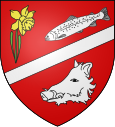Beard (doubs)
| beard | ||
|---|---|---|

|
|
|
| region | Bourgogne-Franche-Comté | |
| Department | Doubs | |
| Arrondissement | Montbeliard | |
| Canton | Montbeliard | |
| Community association | Pays de Montbéliard agglomeration | |
| Coordinates | 47 ° 30 ' N , 6 ° 46' E | |
| height | 309-480 m | |
| surface | 3.84 km 2 | |
| Residents | 1,980 (January 1, 2017) | |
| Population density | 516 inhabitants / km 2 | |
| Post Code | 25420 | |
| INSEE code | 25043 | |
 Mairie Beard |
||
Bart is a French commune with 1,980 inhabitants (as of January 1 2017) in Doubs in the region Bourgogne Franche-Comté .
geography
Bart is located at 315 m , about three kilometers southwest of the city of Montbéliard (as the crow flies). The village extends on the western edge of the basin of Montbéliard in the valley of the Allan just before its confluence with the Doubs , at the eastern foot of the Mont Bart and on the northern edge of the extreme ridges of the Jura .
The area of the 3.84 km² municipal area includes a section of the Allantal. The central part of the area is occupied by the approximately one kilometer wide flat valley of the Allan, which flows south and is accompanied by the waterway of the Rhine-Rhône Canal . At Bart the Rupt flows from the west . To the south, the municipality extends to the confluence of the Allan and Doubs. To the east of the Allan, the community area extends over a hill into the broad Doubstal. The western part of the municipality is much more in relief and includes the wooded heights of the Forêt des Brusses ( 410 m ) and Mont Bart , on which the highest point of Bart is reached at 480 m. In between there is the valley cut of the Ruisseau du Rupt.
Neighboring municipalities of Bavans are Sainte-Suzanne in the north, Courcelles-lès-Montbéliard in the east, Voujeaucourt in the south and Bavans , Présentevillers and Dung in the west.
history
Various finds indicate that the municipality of Bart was already settled in prehistoric times. The place name goes back to the Celtic word bar (obstacle, elevation). Bart is first mentioned in a document in 1150. Since the Middle Ages, the village has belonged to the county of Württemberg-Mömpelgard (Montbéliard) . Businesses that were dependent on water power (mills, sawmills) settled along the Allan very early on. At the beginning of the 17th century, an iron hammer was founded, which over time developed into a metal and steel mill. With the occupation of the county of Montbéliard, Bart finally came into French hands in 1793. Today the village is part of the Pays de Montbéliard Agglomération municipal association .
Attractions
The combined building of a Lutheran church (temple) and school in Bart was inaugurated in 1877. Fort du Mont Bart, which was built from 1873 to 1877 as part of the Belfort-Montbéliard fortress system, is located on Mont Bart, but just outside the municipal area.
population
| Population development | |
|---|---|
| year | Residents |
| 1962 | 1,385 |
| 1968 | 1,516 |
| 1975 | 1,852 |
| 1982 | 1,874 |
| 1990 | 2,074 |
| 1999 | 2,076 |
| 2004 | 1,966 |
| 2016 | 2.015 |
With a population of 1980 (as of January 1, 2017), Bart is one of the medium-sized municipalities in the Doubs department. Since the beginning of the 20th century, a continuous increase in population has been recorded (597 people were counted in 1901), which lasted until the beginning of the 1990s. In the period from 1950 to 1990, the number of inhabitants doubled. In the mid-1990s, the highest level to date was reached with around 2100 inhabitants. Since then, a slight decrease of a little more than 5% has been registered. Today the settlement area of Bart has merged with those of Sainte-Suzanne, Voujeaucourt and Bavans.
Economy and Infrastructure
Bart was already a community shaped by industry and trade in the 19th century. Industrial and commercial zones lie along the Allan and the main street. The Peugeot factory, located between the canal and the railway line, which once employed up to 1,000 people, ceased operations. The area was bought by the Communauté d'Agglomération du Pays de Montbéliard in order to put it to a new use. Companies in the construction and architecture, cleaning, metal and wood processing and precision mechanics sectors are represented in Bart. There are also numerous retail stores. In the meantime, the village has also turned into a residential community. Many workers are therefore commuters who do their work in the Montbéliard agglomeration.
The village is well developed in terms of traffic. It is located on the RN 463 , which leads from Montbéliard to L'Isle-sur-le-Doubs and on to Besançon . The closest connection to the A36 motorway is around five kilometers away. Other road links exist with Voujeaucourt, Arcey and Dung. Part of the slopes of the Montbéliard-Courcelles airfield in the Doubs valley are located on the commune of Bart.
literature
- Le Patrimoine des Communes du Doubs. Volume 2, Flohic Editions, Paris 2001, ISBN 2-84234-087-6 , p. 693.
Web links
Individual evidence
- ↑ See "Bart: le temple" , on: Les temples ou églises luthériennes de France , accessed on January 23, 2016.

